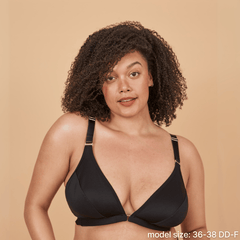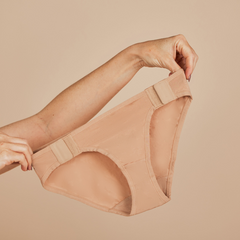We independently determine all recommended products. If you click on links we provide, we may receive compensation.
When a loved one experiences a stroke, it often becomes the responsibility of those around them to assist with tasks that were once effortless.
As you navigate this adjustment period following a stroke, it can be challenging to determine the most effective ways to offer support and assistance.
Helping with dressing is just one of the ways in which you can help stroke patients to be more comfortable and continue with life in as normal a way as possible.

How To Dress A Stroke Patient
Many stroke survivors will struggle with mobility on top of the cognitive impacts of their condition. These can both make tasks like dressing more difficult.
To help stroke patients rebuild confidence and independence there are a few extra steps you can take when supporting them.
Here are some of our top dressing techniques for stroke patients.
1. Lay out the clothing in the order it will be put on. This visual arrangement can help stroke patients to follow a logical order whilst getting dressed. This makes the task feel less overwhelming.
2. Try to help with one garment at a time. Guide them through each step, providing gentle instructions and support as needed. When mobility is more difficult, it can take more focus to get dressed.
3. Break down the dressing process into manageable steps. For example, first, assist with putting on a bra (or help them by buying them adaptive underwear or a gift card so they can do this themselves), then move on to the top, followed by bottoms, and so on. Break it down into steps to make it less daunting and more manageable for stroke patients.
4. Encourage independence where possible and find a middle ground in the support you provide.
Help stroke survivors to attempt smaller tasks independently and provide verbal cues or prompts when needed. For instance, you could try to say, "Now, let's put your right arm through the sleeve," or "Try fastening the bra using the Velcro straps."
Dressing tools or adaptive clothing can be a great way to encourage this independence whilst avoiding frustration.
5. Allow some extra time for dressing. Recognize that it may take longer to dress stroke patients, and allocate plenty of time for it to prevent rushing or frustration. Remain patient, supportive, and understanding throughout the process.
6. Where you can, try to offer choices and involve stroke patients in decision-making. Offer options and ask for preferences when selecting outfits, colors, or patterns. This involvement can foster a sense of control and personal expression.
It can be frustrating to rely on those around you, and that little bit of choice can make a world of difference to someone's confidence and how they feel about receiving help.

Some Bonus Tips and Tricks To Dress A Stroke Patient
Here are a few of our bonus tips for caregivers, including some great product suggestions for bras for stroke patients and other dressing and mobility tools.
Invest In Accessible Clothing and Underwear
Opt for clothing with magnetic or velcro closures instead of buttons or hooks to make dressing more simple. They are easier to manipulate and require less dexterity and hand strength.
Our top recommendation for adaptive clothing is of course the Springrose Adaptive Bra. It’s front fastening, doesn’t rely on difficult clasps, and can be put on one handed. It’s designed for those who value independence and style.
Where adaptive clothing isn’t an option, consider some tools to help simplify dressing and encourage independence where mobility might be difficult.Choose Simple Styles
Stretchy fabrics provide flexibility and accommodate for any limited movement. They allow stroke patients to dress comfortably without feeling restricted.
Celebrate Small Victories
Acknowledge and celebrate even the smallest achievements and milestones during the dressing process. It’s about helping your loved one feel supported and comfortable so it should always be as positive as possible.



